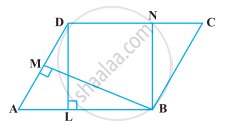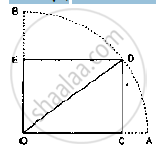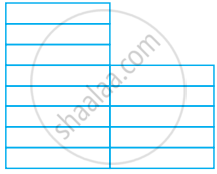Advertisements
Advertisements
Question
In the following figure, the area of parallelogram ABCD is ______.

Options
AB × BM
BC × BN
DC × DL
AD × DL
Solution
In the following figure, the area of parallelogram ABCD is DC × DL.
Explanation:

We know that, area of parallelogram is the product of its any side and the corresponding altitude (or height).
Here, when AB is base, then height is DL.
Area of parallelogram = AB × DL and when AD is base, then height is BM.
Area of parallelogram = AD × BM When DC is base, then height is DL.
Area of parallelogram = DC × DL and when BC is base, then height is not given.
APPEARS IN
RELATED QUESTIONS
In the below fig. OCDE is a rectangle inscribed in a quadrant of a circle of radius 10 cm. If
OE = 2√5, find the area of the rectangle.

If AD is a median of a triangle ABC, then prove that triangles ADB and ADC are equal in
area. If G is the mid-point of median AD, prove that ar (Δ BGC) = 2 ar (Δ AGC).
ABCD is a parallelogram in which BC is produced to E such that CE = BC. AE intersects
CD at F.
(i) Prove that ar (ΔADF) = ar (ΔECF)
(ii) If the area of ΔDFB = 3 cm2, find the area of ||gm ABCD.
PQRS is a trapezium having PS and QR as parallel sides. A is any point on PQ and B is a point on SR such that AB || QR. If area of ΔPBQ is 17cm2, find the area of ΔASR.
In a ΔABC if D and E are mid-points of BC and AD respectively such that ar (ΔAEC) = 4cm2, then ar (ΔBEC) =
Find the area of a rectangle whose length = 8.5 m breadth = 5 m.
Altogether how many squares can be arranged on it?
The region given in the following figure is measured by taking  as a unit. What is the area of the region?
as a unit. What is the area of the region?
Whose footprint is larger - yours or your friend’s?
Find the area of the following figure by counting squares:

